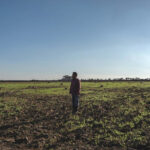Gaza stands on the brink of the most predictable and preventable famine in modern history. It may be the first famine driven entirely by the deliberate denial of aid, not drought or natural disaster. But while the circumstances are new, we know all too tragically what comes next. A decade ago, the world watched famine sweep across Somalia — slowly, then all at once. Images of starving children made headlines, but international action came too late. By the time the famine ended, a quarter of a million people were dead. Gaza may now be on the same path.
Today in Gaza, 470,000 people — one in five — are experiencing famine conditions, the highest proportion anywhere in the world. That’s nearly identical to figures in Somalia when famine was declared in 2011 (490,000 people) and nearly six times higher than figures when famine was declared in parts of South Sudan in 2017.
Every indicator in Gaza is now flashing red.
All signs indicate Gaza is at a tipping point. My organization, MedGlobal, is racing to combat a tidal wave of malnutrition across Gaza. My colleagues talk of adults now collapsing in the streets. I’ve worked on horrific crises like Syria and Yemen, but never one where even my own colleagues — aid workers — were at risk of starving.
The only question now is whether the world will act in time, by applying the lessons we swore we’d never forget and pressuring Israel to change course.
First, the UN and NGOs know how to stop famines. Since Somalia, UN agencies and NGOs have built a strong track record of famine prevention. In 2017 alone, they largely prevented four projected famines in Nigeria, South Sudan, Somalia, and Yemen. They have since held off famine warnings in Yemen and Afghanistan. These are organizations that major governments have vetted, funded, and trusted to deliver.
Gaza is now the exception. Since March, Israel has imposed a blockade to stop humanitarian organizations from bringing in the vast majority of aid. In the last two months, 1,600 trucks have been allowed to enter — barely three days’ worth of aid — after months of nothing. That’s an average of 30 trucks per day — a 95% drop compared to the peak during the ceasefire this year, when 600 trucks were entering. Millions of dollars’ worth of food, medicine, and nutrition aid sit just outside the border, wasted while Palestinians starve, because Israel has not approved its entry. UNRWA alone says it has 6,000 trucks of aid waiting, while the World Food Programme has enough food aid ready to feed all of Gaza for three months. This week, Israel announced it will allow a mere one-week scale-up of aid. It is a first step in the right direction, but only a drop in the ocean of what is needed.
Second, babies and toddlers die first during famines. In Somalia’s famine, half of all deaths were children under five. That pattern is now unfolding in Gaza. MedGlobal teams are seeing a disturbing rise this summer in severe acute malnutrition — the deadliest form, when children are up to ten times more likely to die. Some infants are in the process of dying almost as soon as they’re born. Aid shortages mean MedGlobal teams can no longer run large preventative nutrition programs to stop more children from reaching this point. At one hospital we support in Gaza City, our staff now report 200 to 300 children are arriving per day.
Just last week, five malnourished children being treated by MedGlobal died because we did not have basic supplies. Meanwhile, MedGlobal has enough nutrition supplies to help thousands of children cruelly stuck just out of reach, outside Gaza’s borders without Israeli approval to enter. We have a simple, miracle solution: a vitamin-fortified, peanut-based treatment called RUTF that can help save them. Every single death of a malnourished child at our clinics was preventable.
Third, in a famine, disease often kills first — and forced displacement accelerates it. Famine is a health emergency. During mass starvation, people’s immune systems collapse. Simple infections, diarrhea, malaria or pneumonia can become fatal.
When there’s risk of a famine, one of the most dangerous decisions would be to concentrate displaced people in overcrowded areas without basic services, including clean water or sanitation. Yet that is exactly what Israel is forcing in Gaza. Nearly 90% of Gaza is under Israeli displacement orders or a red zone, with the expectation that two million people will cram into the sliver of land that is left. If Israel carries out a rumored forced mass relocation of Palestinians into detention camps in southern Gaza, it could ignite deadly outbreaks and cement the descent into mass death.
Fourth, food alone cannot halt this humanitarian catastrophe. The only actor allowed to operate unrestricted in Gaza — the new Gaza Humanitarian Foundation under a US/Israeli militarized scheme — provides only food across four sites, and even this has failed to halt worsening food insecurity and led to repeated massacres of civilians. Even if adequate food supplies entered Gaza, it’s simply not enough at this stage. Malnourished children require specialized nutrition treatment to survive, and professional health workers for those that need to be hospitalized. Families need clean water and functioning toilets to halt disease.
But in Gaza, 94% of all hospitals in the Gaza Strip are damaged or destroyed. Hundreds of medical workers, including MedGlobal’s own staff, have been detained. Water is undrinkable. Sewage systems have collapsed. Famine prevention requires all hands on deck — all humanitarian agencies surging in to halt this crisis from all directions.
Lastly, by the time the data confirms a famine, it’s too late to act. In Somalia, it took two years before a post-mortem analysis gave us all the numbers I’ve cited here. It found that half of all deaths — 130,000 — occurred before famine was even declared. As aid runs out, clinics and hospitals will shut down, creating a dangerous blind spot. We’ll increasingly lose visibility into the true scale of the crisis. Children will die in tents and displacement camps, out of sight.
Every indicator in Gaza is now flashing red. If the world waits for mortality projections or more images of starved children to act, it will once again be documenting a preventable tragedy after the fact, rather than intervening when it mattered most.
Israel must lift its blockade and allow all humanitarian aid to flow in — every day, without interference. While Somalia’s catastrophe was driven by complex factors, including a major drought, Gaza’s descent into famine is by design, a man-made crisis. Each death is not just a tragedy. It is a choice. There is still time to save hundreds of thousands of lives if only the world would act.




















